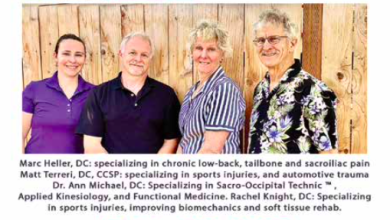STRAINS AND SPRAINS AND ALL THAT PAIN
You twisted your ankle and it hurts – a lot! It’s swollen, black, and blue. Or you have been typing at the computer for two days straight and your right elbow is really starting to hurt. You finish your typing project, but your elbow continues to hurt, and you’re not really sure what to do next.
These are common injuries I see every day at Southern Oregon Sports & Spine. They are typically categorized into strains or sprains. Quick anatomy lesson: strains have to do with muscles. Sprains have to do with ligaments. Muscles terminate into tendons that attach to bones, and ligaments span across the joints of bones to hold joints in place.
When a muscle or ligament is injured, it is often graded.
When you strain a muscle you actually tear or damage the muscle – even if it’s on a microscopic level. The mildest example I can think of is when you lift weights at the gym – you are tearing down muscle and they repair themselves while you rest.
Grading System: for muscles Grade I is mild damage – less than 5% of muscle fibers with minimal loss to strength and motion. Grade II is damage beyond 5%, and Grade III is a complete tear (or rupture) of a muscle. Complete tears usually involve a lot of bruising and there is no strength in the muscle because it is torn all the way through – we’re also talking major pain here! Grade II strains can bruise and hurt a lot too!
Ligaments go through a similar grading system: Grade I is when a ligament is stretched or has slight tearing. There will be mild tenderness, swelling and stiffness, but the joint will feel mostly stable. Grade II is a larger tear with moderate bruising and swelling. It is usually painful to the touch and the joint may or may not feel stable (think trying to walk on a sprained ankle). Grade III again is a complete tear with severe swelling and bruising. The joint is unstable (meaning you can’t use it).
Healing times for both can vary from 2 to 4 weeks (Grade I), 6-8 weeks (Grade II) or months for Grade III. These are approximate times and can vary from person to person.
Most of the time people heal from Grade I or II sprains and strains just fine. Care is often needed to help stabilize and strengthen the area. Sometimes x-rays have to be ordered to rule out fractures. Unfortunately, many Grade III injuries have to be surgically repaired, then rehabilitation can start.
My experience has been that the sooner these injuries are addressed the better. Procrastinating will often result in longer or delayed healing times.
Matt Terreri, DC, CCSP is a sports chiropractor at Southern Oregon Sports & Spine. He is also the official chiropractor for the SOU Raiders and is a regular volunteer medical provider for the US Olympic Teams.



